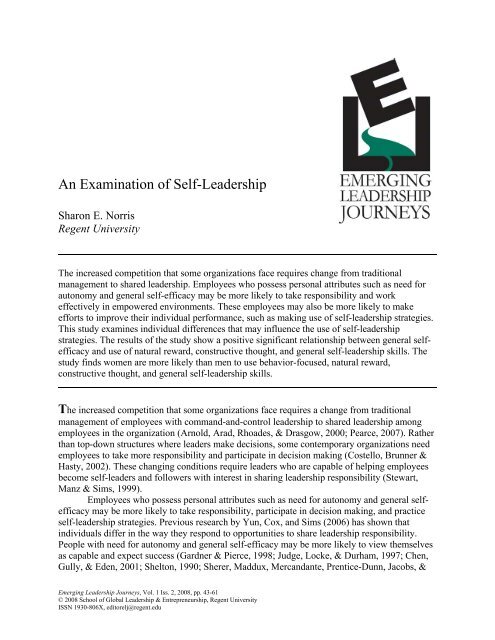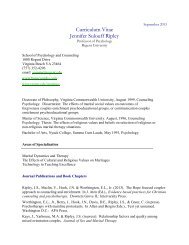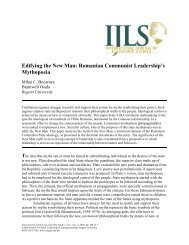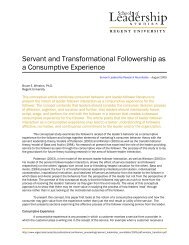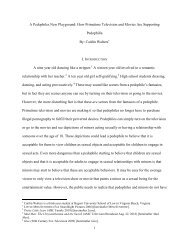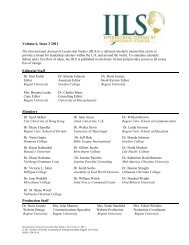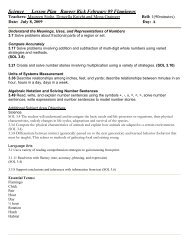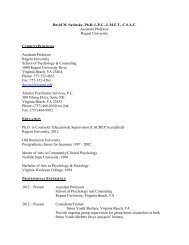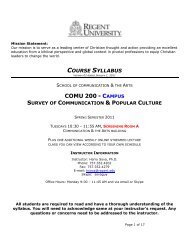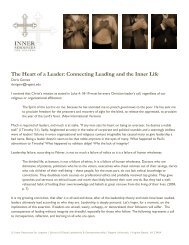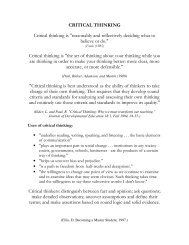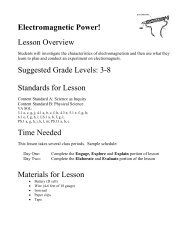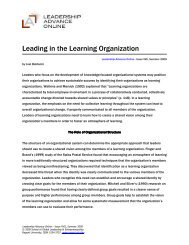An Examination of Self-Leadership - Regent University
An Examination of Self-Leadership - Regent University
An Examination of Self-Leadership - Regent University
You also want an ePaper? Increase the reach of your titles
YUMPU automatically turns print PDFs into web optimized ePapers that Google loves.
<strong>An</strong> <strong>Examination</strong> <strong>of</strong> <strong>Self</strong>-<strong>Leadership</strong><br />
Sharon E. Norris<br />
<strong>Regent</strong> <strong>University</strong><br />
The increased competition that some organizations face requires change from traditional<br />
management to shared leadership. Employees who possess personal attributes such as need for<br />
autonomy and general self-efficacy may be more likely to take responsibility and work<br />
effectively in empowered environments. These employees may also be more likely to make<br />
efforts to improve their individual performance, such as making use <strong>of</strong> self-leadership strategies.<br />
This study examines individual differences that may influence the use <strong>of</strong> self-leadership<br />
strategies. The results <strong>of</strong> the study show a positive significant relationship between general selfefficacy<br />
and use <strong>of</strong> natural reward, constructive thought, and general self-leadership skills. The<br />
study finds women are more likely than men to use behavior-focused, natural reward,<br />
constructive thought, and general self-leadership skills.<br />
The increased competition that some organizations face requires a change from traditional<br />
management <strong>of</strong> employees with command-and-control leadership to shared leadership among<br />
employees in the organization (Arnold, Arad, Rhoades, & Drasgow, 2000; Pearce, 2007). Rather<br />
than top-down structures where leaders make decisions, some contemporary organizations need<br />
employees to take more responsibility and participate in decision making (Costello, Brunner &<br />
Hasty, 2002). These changing conditions require leaders who are capable <strong>of</strong> helping employees<br />
become self-leaders and followers with interest in sharing leadership responsibility (Stewart,<br />
Manz & Sims, 1999).<br />
Employees who possess personal attributes such as need for autonomy and general selfefficacy<br />
may be more likely to take responsibility, participate in decision making, and practice<br />
self-leadership strategies. Previous research by Yun, Cox, and Sims (2006) has shown that<br />
individuals differ in the way they respond to opportunities to share leadership responsibility.<br />
People with need for autonomy and general self-efficacy may be more likely to view themselves<br />
as capable and expect success (Gardner & Pierce, 1998; Judge, Locke, & Durham, 1997; Chen,<br />
Gully, & Eden, 2001; Shelton, 1990; Sherer, Maddux, Mercandante, Prentice-Dunn, Jacobs, &<br />
Emerging <strong>Leadership</strong> Journeys, Vol. 1 Iss. 2, 2008, pp. 43-61<br />
© 2008 School <strong>of</strong> Global <strong>Leadership</strong> & Entrepreneurship, <strong>Regent</strong> <strong>University</strong><br />
ISSN 1930-806X, editorelj@regent.edu
Need for<br />
autonomy<br />
General<br />
self-efficacy<br />
Emerging <strong>Leadership</strong> Journeys, Vol. 1 Iss. 2, 2008, pp. 43-61<br />
© 2008 School <strong>of</strong> Global <strong>Leadership</strong> & Entrepreneurship, <strong>Regent</strong> <strong>University</strong><br />
ISSN 1930-806X, editorelj@regent.edu<br />
EMERGING LEADERSHIP JOURNEYS 44<br />
Rogers, 1982; Yun et al.). They may also desire control and influence over their work and may<br />
want to make decisions related to their jobs (Yun et al.). Individuals with high general selfefficacy<br />
may also be more likely to believe they can accomplish what they want to accomplish<br />
(Maddux, 2002). Individuals characterized as self-leaders direct their own efforts, persist in<br />
situations <strong>of</strong> adversity, personally motivate themselves, and continually renew thinking patterns<br />
(Manz & Sims, 1989).<br />
<strong>Self</strong>-leaders may be more likely to engage in innovative behaviors in the workplace<br />
(Carmeli, Meitar, & Weisberg, 2006), and self-leadership represents a self-influence process that<br />
involves self-direction and self-motivation (DiLiello & Houghton, 2006; Manz & Neck, 2004).<br />
Individuals who use self-leadership strategies enhance their personal effectiveness through<br />
behavior-focused, natural reward and constructive thought strategies (Manz & Neck; Manz &<br />
Sims, 2001; Prussia, <strong>An</strong>derson, & Manz, 1998). Behavior-focused strategies help facilitate<br />
behavior management. Natural reward strategies helps individuals shape perceptions and build<br />
enjoyable aspects into activities and constructive thought strategies create positive ways <strong>of</strong><br />
thinking (Neck & Houghton, 2006).<br />
In environments where employees are encouraged to act on their own behalf and take<br />
greater control (Conger & Kanungo, 1988; Staples, 1990; Prussia et al., 1998), the strategies <strong>of</strong><br />
self-leadership may be useful for achieving the necessary self-direction and self-motivation to<br />
perform well (Neck & Houghton, 2006). Therefore, practitioners and researchers alike may<br />
benefit from gaining insight about what influences the use <strong>of</strong> self-leadership strategies. The<br />
present study attempts to answer one overarching research question: Are there individual<br />
differences that influence the likelihood that a person will use self-leadership strategies?<br />
In this empirical study, this research question is examined with a sample <strong>of</strong> graduate<br />
students from a small, liberal arts university in the Midwest. Previous self-leadership studies<br />
have focused on theoretical propositions regarding autonomous action and general self-efficacy<br />
on self-leadership (e.g., DiLiello & Houghton, 2006; Manz, 1986; Markham & Markham, 1995;<br />
Neck & Houghton, 2006). No previous study has examined the influence <strong>of</strong> general self-efficacy<br />
on self-leadership; although, an association between self-leadership and general self-efficacy is<br />
proposed conceptually (Neck & Houghton, 2006; Williams, 1997). The purpose <strong>of</strong> the present<br />
study is to examine the relationship between need for autonomy and general self-efficacy on selfleadership,<br />
to determine the extent to which these individual differences influence the use <strong>of</strong> selfleadership<br />
strategies. A model <strong>of</strong> the hypothesized relationship among need for autonomy,<br />
general self-efficacy and self-leadership strategies is shown in Figure 1.<br />
<strong>Self</strong>-leadership<br />
strategies<br />
Figure 1. Model <strong>of</strong> hypothesized relationship among need for autonomy, general self-efficacy,<br />
and self-leadership strategies.
Emerging <strong>Leadership</strong> Journeys, Vol. 1 Iss. 2, 2008, pp. 43-61<br />
© 2008 School <strong>of</strong> Global <strong>Leadership</strong> & Entrepreneurship, <strong>Regent</strong> <strong>University</strong><br />
ISSN 1930-806X, editorelj@regent.edu<br />
EMERGING LEADERSHIP JOURNEYS 45<br />
Model Development<br />
Are there individual differences that influence the likelihood a person will use selfleadership<br />
strategies? <strong>An</strong>swering this research question is the focus <strong>of</strong> this study. This empirical<br />
study tests the relationship between need for autonomy and general self-efficacy on selfleadership.<br />
<strong>Self</strong>-<strong>Leadership</strong><br />
The theoretical foundation <strong>of</strong> self-leadership is built upon social learning theory<br />
(Bandura, 1977) and social cognitive theory (Bandura, 1986). Social leaning theory (Bandura,<br />
1977, 1997) explains how people can influence their own cognition, motivation, and behavior<br />
(Yun et al., 2006). Social cognitive theory explains that people and their environment interact<br />
continually (Satterfield & Davidson, 2000) and behavioral consequences serve as sources <strong>of</strong><br />
information and motivation (Bandura, 1986; Schunk, 2001). <strong>Self</strong>-leadership explains how selfleaders<br />
think and how they behave according to cognitive, motivational, and behavioral<br />
strategies (Kraft, 1998; Prussia et al., 1998; Yun et al., 2006).<br />
The three strategies associated with self-leadership include behavior-focused, natural<br />
reward, and constructive thought strategies (Manz & Neck, 2004; Neck & Houghton, 2006;<br />
Prussia et al., 1998). Behavior-focused strategies heighten self-awareness and facilitate personal<br />
behavioral management through methods such as self-goal setting, self-reward, self-punishment,<br />
self-observation, and self-cueing (Neck & Houghton, 2006). Natural reward strategies help<br />
people build pleasant and enjoyable features into their activities so that the tasks themselves<br />
become naturally rewarding (e.g., Manz & Neck, 2004). Natural reward strategies increase<br />
intrinsic motivation, self-determination, and feelings <strong>of</strong> competence (Deci & Ryan, 1985; Neck<br />
& Houghton, 2006). Constructive thought strategies create positive habitual ways <strong>of</strong> thinking and<br />
negative destructive self-talk is replaced by optimistic self-talk (Seligman, 1991; Neck &<br />
Houghton, 2006). Constructive thought strategies can change thinking patterns (Prussia et al.,<br />
1998) and positively impact outcome expectations (Boss & Sims, 2008).<br />
Need for Autonomy<br />
Need for autonomy influences self-leadership and helps motivate autonomous action<br />
(Deci & Ryan, 2000; Edmunds, Ntoumanis & Duda, 2006; Yun et al., 2006) as explained by the<br />
self-determination theory (Deci, 1975; Deci & Ryan, 1985, 2000). <strong>Self</strong>-determination theory<br />
explains that the degree <strong>of</strong> a person’s self-motivation is determined by the extent to which his or<br />
her behavior or actions are autonomous or controlled (Deci & Ryan, 2000). External forces that<br />
pressure an individual to engage in particular behaviors describe controlled actions, whereas<br />
freely initiated behaviors that emanate from within a person explain autonomous actions<br />
(Edmunds et al., 2006; Reeve, 2002).<br />
Deci and Ryan (1985) explained that autonomously-oriented individuals make choices<br />
using the information available to them and they regulate themselves as they pursue self-selected<br />
goals. <strong>Self</strong>-determined choices are considered motivational behaviors when the choice <strong>of</strong> action<br />
flows freely, intuitively, and spontaneously (Czikszentmihalyi, 1975; Deci & Ryan, 1985). When<br />
constraints exist or situations in the environment limit choices, autonomously-oriented people<br />
may make a “choiceful accommodation” (Deci & Ryan, 1985). In this way, the limitation is
Emerging <strong>Leadership</strong> Journeys, Vol. 1 Iss. 2, 2008, pp. 43-61<br />
© 2008 School <strong>of</strong> Global <strong>Leadership</strong> & Entrepreneurship, <strong>Regent</strong> <strong>University</strong><br />
ISSN 1930-806X, editorelj@regent.edu<br />
EMERGING LEADERSHIP JOURNEYS 46<br />
transformed into another piece <strong>of</strong> information that is used in making decisions (Deci & Ryan,<br />
1985). In other words, the rejected options are fully considered and the person experiences<br />
freedom to select among all the choices available. Deci and Ryan (1985) explained autonomous<br />
action involves making flexible, genuine choices and genuine choice means truly entertaining<br />
more than one option.<br />
People have a natural need for autonomy as well as a natural need to freely choose their<br />
behaviors (deCharms, 1968; Deci, 1975; Vansteenkiste, Neyrinck, Niemiec, Soenens, De Witte,<br />
& Van den Broeck, 2007). In essence, human agency, rationality, and autonomy are conceptually<br />
linked in a theory <strong>of</strong> human need (Tao, 2004). Mill (1998) promoted the idea that people should<br />
be free to make choices. Kant (1959) indicated that self-governance and self-legislation are<br />
connected with morality; therefore, the capacity to exert control through choice is a foundational<br />
requirement <strong>of</strong> respect for persons (Tao). “Judgment is given to men that they use it” (Mill,<br />
1998, p. 23).<br />
The need for autonomy refers to a person’s desire to engage in activities <strong>of</strong> his or her<br />
choosing (deCharms, 1968; Deci, 1975; Deci & Ryan, 1985; Edmunds et al., 2006). People with<br />
a desire or predisposition to take responsibility, act independently, and make decisions about<br />
their job have been characterized as employees with a high need for autonomy (Kupfer, 1990;<br />
Mathis & Jackson, 2006; Yun et al., 2006). Need for autonomy explains expectations about<br />
making independent choices, participating in the decision process (Yun et al.), taking<br />
autonomous action, and choosing for oneself both what to think and what to do (Kupfer, 1990).<br />
The need for autonomy on the job refers to the extent to which individuals desire freedom<br />
and discretion in their work (Mathis & Jackson, 2006). Research studies support the proposition<br />
that employees with high need for autonomy desire to make independent choices and participate<br />
in decision making (Harrell & Alpert, 1979; Yun et al., 2006). Making independent choices and<br />
participating in decision-making have been found to represent characteristics <strong>of</strong> educated,<br />
ambitious people who want to be managers and leaders (Harrell & Alpert). Yun et al. tested the<br />
interaction between need for autonomy on self-leadership, and they found a positive relationship<br />
between these constructs; therefore, this study proposes a positive relationship exists between<br />
need for autonomy and use <strong>of</strong> self-leadership strategies.<br />
H1: There will be a positive relationship between need for autonomy and use <strong>of</strong> self-<br />
leadership strategies.<br />
General <strong>Self</strong>-Efficacy<br />
Social cognitive theory provides insight regarding self-efficacy and explains where selfefficacy<br />
comes from and how it develops (Maddux, 2002). The theory postulates people are<br />
active shapers <strong>of</strong> their environment, not merely passive reactors (Bandura, 1986, Barone,<br />
Maddux, & Snyder, 1997). <strong>Self</strong>-efficacy beliefs develop over time and through experiences<br />
(Maddux, 2002). <strong>Self</strong>-efficacy refers to beliefs about personal capability to produce a desired<br />
effect by individual action (Bandura, 1997). <strong>Self</strong>-efficacy helps explain the behaviors people will<br />
engage, how long they will persist, and how much effort they will expend to reach their goals<br />
(Satterfield & Davidson, 2000). People with high self-efficacy may be more likely to overcome<br />
difficulties through self-initiated change, more likely to be goal-directed and more persistent in<br />
the achievement <strong>of</strong> that goal (Maddux, 2002). In essence, the self-assessments that people make
Emerging <strong>Leadership</strong> Journeys, Vol. 1 Iss. 2, 2008, pp. 43-61<br />
© 2008 School <strong>of</strong> Global <strong>Leadership</strong> & Entrepreneurship, <strong>Regent</strong> <strong>University</strong><br />
ISSN 1930-806X, editorelj@regent.edu<br />
EMERGING LEADERSHIP JOURNEYS 47<br />
in determining personal capacity to perform refer to self-efficacy (Bandura, 1986, 1991; Gist,<br />
1987; Neck & Houghton, 2006).<br />
People with general self-efficacy tend to deal more effectively with difficulties and<br />
persist in the face <strong>of</strong> failure (Cordery & Burr, 2005; Gist & Mitchell, 1992; Judge & Bono,<br />
2001). They may also be more confident in their fundamental abilities to cope, perform, and be<br />
successful (Cordery & Burr; Judge & Bono). DeRue and Morgeson (2007) posited that<br />
individuals with general self-efficacy attribute success to ability and failure to insufficient effort.<br />
Chen, Gully, and Eden (2004) indicated that general self-efficacy is a motivational belief or<br />
judgment about personal capabilities that influences personal action in a wide variety <strong>of</strong><br />
situations.<br />
General self-efficacy refers to an accumulation <strong>of</strong> life successes that have emerged as a<br />
result <strong>of</strong> previous experience (Bandura, 1977; Chen et al., 2001). Rather than a malleable statelike<br />
belief, general self-efficacy represents a stable, trait-like belief (Chen et al., 2004). Various<br />
self-leadership studies identify specific task self-efficacy as a construct influential in the use <strong>of</strong><br />
self-leadership strategies (e.g., Prussia et al., 1998). Yet, Neck and Houghton (2006)<br />
recommended that researchers should investigate the relationship between self-leadership and<br />
general self-efficacy. Previous research studies have also suggested a theoretical relationship<br />
exists between general self-efficacy and self-leadership (Neck & Houghton, 2006; Williams,<br />
1997). Conceptually, general self-efficacy may influence self-leadership (Neck & Houghton,<br />
2006). The present study empirically tests the relationship between general self-efficacy and selfleadership<br />
to determine if general self-efficacy beliefs influence the use self-leadership<br />
strategies.<br />
Sample<br />
H2: There will be a positive relationship between general self-efficacy and self-<br />
leadership.<br />
Method<br />
Graduate students (N = 124) enrolled in summer courses at a small, liberal arts university<br />
in the Midwest were invited to participate in the study. Participation was voluntary but<br />
encouraged and responses were anonymous and confidential. The actual sample consisted <strong>of</strong> 121<br />
graduate students representing a 97.5% participation rate. The average age <strong>of</strong> participants was<br />
approximately 36 years (SD = 9.67), and the sample was made up <strong>of</strong> 59.5% females and 40.5%<br />
males. The average tenure <strong>of</strong> participants was 6.68 years (SD = 6.78) with a range <strong>of</strong> tenure<br />
between 1 and 30 years.<br />
Procedures<br />
A single stage sampling procedure was utilized for drawing the convenience sample from<br />
the population <strong>of</strong> interest (Creswell, 2003). A questionnaire was used for collecting data from<br />
graduate students. Permission was obtained from graduate faculty for administering the survey<br />
and students received informed consent information along with procedures for the study. <strong>An</strong><br />
attempt was made to increase the likelihood <strong>of</strong> obtaining the true score on need for autonomy,<br />
general self-efficacy, and self-leadership strategies rather than scores with systematic error by
Emerging <strong>Leadership</strong> Journeys, Vol. 1 Iss. 2, 2008, pp. 43-61<br />
© 2008 School <strong>of</strong> Global <strong>Leadership</strong> & Entrepreneurship, <strong>Regent</strong> <strong>University</strong><br />
ISSN 1930-806X, editorelj@regent.edu<br />
EMERGING LEADERSHIP JOURNEYS 48<br />
reducing evaluation apprehension (Donaldson & Grant-Vallone, 2002; Podsak<strong>of</strong>f, MacKenzie,<br />
Lee, & Podsak<strong>of</strong>f, 2003). Respondents were assured <strong>of</strong> anonymity, and they were informed that<br />
there was no right or wrong answers (Podsak<strong>of</strong>f et al.). The questionnaires were administered in<br />
a group setting at the start <strong>of</strong> class sessions and respondents took approximately 15 minutes to<br />
complete the survey.<br />
The study took place in face-to-face classrooms among graduate students enrolled in<br />
summer courses at a small, liberal arts university located in the Midwest. A questionnaire with<br />
closed-ended statements was administered in paper-and-pencil format. The survey included<br />
closed-ended statements with fixed responses. Responses were obtained to measure need for<br />
autonomy (Yun et al., 2006), general self-efficacy (Chen et al., 2001), and self-leadership<br />
(Houghton & Neck, 2002). <strong>Self</strong>-report information was also gathered from respondents<br />
regarding gender, age, and tenure. In order to address issues <strong>of</strong> self-report bias, Podsak<strong>of</strong>f and<br />
Organ (1986) suggested that researchers may reorder the items on the questionnaire so the<br />
criterion variable follows the independent variables. This scale reordering procedure was<br />
intentional as an attempt to reduce self-report bias, because all the variables in the study were<br />
obtained from the same respondents using a single survey.<br />
Measures<br />
<strong>Self</strong>-leadership strategies. The criterion or dependent variables in the study include the<br />
three self-leadership strategies namely behavior-focused, natural reward, and constructive<br />
thought strategies, along with an overall measure <strong>of</strong> general self-leadership. The dependent<br />
variables were measured using the Revised <strong>Self</strong>-<strong>Leadership</strong> Questionnaire (RSLQ) developed by<br />
Houghton and Neck (2002). There are 35 item statements in the self-leadership scale measuring<br />
behavior-focused, natural reward, and cognitive thought strategies. <strong>Self</strong>-leadership strategies<br />
were scored using a 5-point Likert scale with 1 (not at all accurate), 2 (somewhat accurate), 3 (a<br />
little accurate), 4 (mostly accurate), and 5 (completely accurate). There are nine subscales in the<br />
RSLQ. Behavior-focused self-leadership can be measured with five subscales identified as selfgoal<br />
setting (5 items), self-reward (3 items), self-punishment (4 items), self-observation (4<br />
items), and self-cueing (2 items). Natural reward self-leadership is measured with a single 5-item<br />
scale. Constructive thought self-leadership is measured with three subscales, including<br />
visualizing successful performance (5 items), self-talk (3 items), and evaluating beliefs and<br />
assumptions (4 items). A single measure <strong>of</strong> self-leadership was also computed with the average<br />
scores <strong>of</strong> behavior-focused, natural reward, and constructive thought strategies, and this single<br />
measure is referred to as general self-leadership.<br />
A sample item statement from the behavior-focused dimension is, “I establish specific<br />
goals for my own performance.” A sample item statement from the natural reward dimension is,<br />
“I find my own favorite way to get things done.” A sample item statement from the constructive<br />
thought dimension is, “I visualize myself successfully performing a task before I do it.” The<br />
reliability <strong>of</strong> the scale was established by Houghton and Neck (2002) in two studies with<br />
respondents from two introductory management courses at a large southeastern university, and<br />
they reported internal consistency with the coefficient alpha ranging from .74 to .93. For the<br />
present study, the Cronbach’s alpha was .88 for behavior-focused, .78 for natural reward, .88 for<br />
constructive thought, and .93 for general self-leadership. Table 1 displays the self-leadership<br />
strategies and Cronbach’s alpha for the present study.
Emerging <strong>Leadership</strong> Journeys, Vol. 1 Iss. 2, 2008, pp. 43-61<br />
© 2008 School <strong>of</strong> Global <strong>Leadership</strong> & Entrepreneurship, <strong>Regent</strong> <strong>University</strong><br />
ISSN 1930-806X, editorelj@regent.edu<br />
EMERGING LEADERSHIP JOURNEYS 49<br />
Table 1<br />
<strong>Self</strong>-<strong>Leadership</strong> Strategies and Cronbach’s Alpha (N = 121)<br />
<strong>Self</strong>-<strong>Leadership</strong> Strategies Cronbach’s Alpha, α<br />
Behavior-focused .88<br />
Natural reward .78<br />
Constructive thought .88<br />
General self-leadership .93<br />
Need for autonomy. Need for autonomy was measured with a scale developed by Yun et<br />
al. (2006), and the scale measures a person’s desire or predisposition to be independent and free<br />
<strong>of</strong> external control. There are three items statements in the scale. Need for autonomy was scored<br />
using a 5-point Likert scale with 1 (definitely not true), 2 (not true), 3 (neither true nor untrue), 4<br />
(true), and 5 (definitely true). A sample statement from the need for autonomy scale is, “In my<br />
ideal job I would find solutions to my own problems at work without consulting my supervisor.”<br />
The scale was used by Yun et al. (2006) in a self-leadership study and they reported the scale to<br />
be slightly lower than the desired .70 (α = .68). Yun et al. (2006) tested the need for autonomy on<br />
self-leadership and found a positive and significant relationship. For the present study, the<br />
Cronbach’s alpha was .69.<br />
General self-efficacy. General self-efficacy was measured using the New General <strong>Self</strong>-<br />
Efficacy (NGSE) scale developed by Chen et al. (2001). There are eight item statements in the<br />
general self-efficacy scale that measures an individual’s perception <strong>of</strong> ability to perform across a<br />
wide range <strong>of</strong> situations (Chen et al., 2001; Scherbaum, Cohen-Charash, & Kern, 2006). General<br />
self-efficacy was scored using a 7-point Likert scale with 1 (strongly agree), 2 (somewhat<br />
agree), 3 (agree), 4 (neither agree nor disagree), 5 (disagree), 6 (somewhat disagree), and 7<br />
(strongly disagree). A sample statement from the general self-efficacy scales is, “In general, I<br />
think that I can obtain outcomes that are important to me.” The reliability <strong>of</strong> the NGSE scale was<br />
tested by Chen et al. (2001) with 323 undergraduate students from a large mid-Atlantic<br />
university and their study reported internal consistency with the coefficient alpha ranging from<br />
.86 to .90. For the present study, the Cronbach’s alpha was .90.<br />
Control variables. The participants were selected using a non-random sampling<br />
procedure; therefore, the selection process for the study may pose a threat to internal validity<br />
(Kerlinger & Lee, 1999). In an effort to strengthen internal validity <strong>of</strong> the study, gender, age, and<br />
tenure were control variables. Participants provided information regarding gender, age, and<br />
tenure through self-report when completing the self-administered questionnaire. In a previous<br />
study examining the relationship between self-leadership skills and innovation at work, job<br />
tenure, age, and gender were controlled and Carmeli et al. (2006) found these control variables<br />
significantly contributed to the variance in the dependent variable (R 2 = .08; F = 2.46, p = 0.03).<br />
Results<br />
Descriptive Statistics<br />
Responses from the survey were entered into SPSS (Version 15.0) statistical s<strong>of</strong>tware and<br />
were used to compute descriptive statistics. The means and standard deviations are shown in<br />
Table 2 for the control, predictor, and criterion variables <strong>of</strong> the study. Need for autonomy and
Emerging <strong>Leadership</strong> Journeys, Vol. 1 Iss. 2, 2008, pp. 43-61<br />
© 2008 School <strong>of</strong> Global <strong>Leadership</strong> & Entrepreneurship, <strong>Regent</strong> <strong>University</strong><br />
ISSN 1930-806X, editorelj@regent.edu<br />
EMERGING LEADERSHIP JOURNEYS 50<br />
self-leadership strategies were measured using a 5-point Likert scale and general self-efficacy<br />
was measured using a 7-point Likert scale.<br />
Table 2<br />
Descriptive Statistics (N = 121)<br />
Variable M SD<br />
1. Gender a 1.41 .49<br />
2. Age 35.58 9.67<br />
3. Tenure 6.68 6.78<br />
4. Need for autonomy 3.98 .67<br />
5. General self-efficacy 6.14 .70<br />
6. Behavior-focused 3.95 .60<br />
7. Natural reward 3.91 .66<br />
8. Constructive thought 3.61 .72<br />
9. General self-leadership 3.76 .56<br />
a Gender was coded 1 for female and 2 for male.<br />
Correlations<br />
A correlation analysis was performed for examining the nature and degree <strong>of</strong> relationship<br />
among the predictor and criterion variables <strong>of</strong> the study. The results <strong>of</strong> the Pearson r correlation<br />
analysis and internal consistencies are shown in Table 3.<br />
Table 3<br />
Correlations and Internal Consistencies (N = 121)<br />
Variable 1 2 3 4 5 6 7 8 9<br />
1. Gender a<br />
2. Age .04 -<br />
3. Tenure .01 .57** -<br />
4. Need for autonomy .01 .05 .26** (.69)<br />
5. General self-efficacy .00 -.04 .06 .18* (.90)<br />
6. Behavior-focused -.44** -.11 .03 .03 .17 (.88)<br />
7. Natural reward -.39** -.24 -.10 .06 .38** .62** (.78)<br />
8. Constructive thought -.29** .07 .00 .06 .28** .63** .44** (.88)<br />
9. General self-leadership -.44** -.11 -.03 .06 .33** .88** .81** .84** (.93)<br />
Note. Numbers in parentheses are internal reliabilities (Cronbach’s alpha) for each measure.<br />
a<br />
Gender was coded 1 for female and 2 for male.<br />
*p < .05. **p < .01.<br />
Need for autonomy and self-leadership. There is no correlation between the need for<br />
autonomy and general self-leadership (r = .06). Neither is there a correlation between need for
Emerging <strong>Leadership</strong> Journeys, Vol. 1 Iss. 2, 2008, pp. 43-61<br />
© 2008 School <strong>of</strong> Global <strong>Leadership</strong> & Entrepreneurship, <strong>Regent</strong> <strong>University</strong><br />
ISSN 1930-806X, editorelj@regent.edu<br />
EMERGING LEADERSHIP JOURNEYS 51<br />
autonomy and behavior focused (r = .03), natural reward (r = .06) nor constructive thought (r =<br />
.06) self-leadership strategies.<br />
General self-efficacy and self-leadership. There is a positive and significant correlation<br />
between general self-efficacy and general self-leadership (r = .33, p < .01). A positive but weak<br />
and non-significant relationship was found between general self-efficacy and behavior-focused<br />
self-leadership strategies (r = .17). Positive and significant relationships were found between<br />
general self-efficacy and natural reward strategies (r = .38, p < .01) and general self-efficacy and<br />
constructive thought strategies (r = .28, p < .01).<br />
<strong>Self</strong>-leadership. There is a positive and significant relationship between behavior-focused<br />
and natural reward (r = .62, p < .01) and behavior-focused and constructive thought leadership<br />
strategies (r = .63, p < .01). There is also a positive and significant relationship between natural<br />
reward and constructive thought self-leadership strategies (r = .44, p < .01).<br />
Other correlations. There was a correlation found between age and tenure (r = .57, p <<br />
.01) and a positive and significant correlation was found between need for autonomy and general<br />
self-efficacy (r = .18, p < .05). The results <strong>of</strong> the correlation analysis indicate there is a low<br />
correlation between the need for autonomy, general self-efficacy, and general self-leadership<br />
scales; therefore, the empirical data suggests these constructs <strong>of</strong> the model are both theoretically<br />
and empirically distinct.<br />
Hierarchical Regression <strong>An</strong>alysis<br />
General self-leadership analysis. Hierarchical regression analysis was conducted to<br />
examine the contribution <strong>of</strong> specific theory driven variables in explaining the dependent<br />
variables. In order to control for possible confounding influences <strong>of</strong> extraneous variables,<br />
gender, age, and tenure were first entered into the hierarchical procedure and represent Step 1.<br />
Need for autonomy and general self-efficacy, the two additional predictor variables, were added<br />
in the next step and represent Step 2.<br />
The combination <strong>of</strong> the variables in Step 2 significantly predicted general self-leadership,<br />
F(5, 118) = 9.85, p < .01; adjusted R 2 = .27. The beta weights suggest gender (β = -.43, t = -5.49,<br />
p < .01) contributes the most to the explanation <strong>of</strong> general self-leadership. General self-efficacy<br />
(β = .33, t = 4.09, p < .01) is the next significant contributor to the regression equation. The<br />
adjusted R 2 value for Step 1 is .18 indicating 18% <strong>of</strong> the variance in general self-leadership is<br />
explained in model one. The adjusted R 2 for Step 2 is .27 indicating 27% <strong>of</strong> the variance in selfleadership<br />
is explained by model 2. Since the adjusted R 2 value rises from 18% to 27% in model<br />
2, model 2 provides a better explanation <strong>of</strong> the individual differences influential on general selfleadership.<br />
The regression analysis results for general self-leadership are shown in Table 4.
Emerging <strong>Leadership</strong> Journeys, Vol. 1 Iss. 2, 2008, pp. 43-61<br />
© 2008 School <strong>of</strong> Global <strong>Leadership</strong> & Entrepreneurship, <strong>Regent</strong> <strong>University</strong><br />
ISSN 1930-806X, editorelj@regent.edu<br />
EMERGING LEADERSHIP JOURNEYS 52<br />
Table 4<br />
Hierarchical Regression <strong>An</strong>alysis - General <strong>Self</strong>-<strong>Leadership</strong> (N = 121)<br />
General <strong>Self</strong>-<strong>Leadership</strong> B SE B Β<br />
Step 1<br />
Gender -.49 .10 -.43**<br />
Age -.01 .01 -.11<br />
Tenure .00 .01 .04<br />
Step 2<br />
Gender -.49 .09 -.43**<br />
Age .00 .01 -.06<br />
Tenure .00 .01 -.01<br />
Need for autonomy .01 .07 .02<br />
General self-efficacy .26 .06 .33**<br />
Note. R 2 = .20 for Step 1. Adjusted R 2 = .27 for Step 2.<br />
*p < .05. **p < .01.<br />
<strong>Self</strong>-leadership strategies. The same hierarchical regression procedures were followed to<br />
examine the relationship between the predictor variables on behavior-focused, natural reward<br />
and constructive thought self-leadership strategies. When testing behavior-focused selfleadership<br />
strategies, gender (β = -.43, t = -5.24, p < .01) and general self-efficacy (β = .17, t =<br />
2.04, p = .04) significantly contributed to the regression equation, F(5, 118) = 7.01, p < .01;<br />
adjusted R 2 = .20. The hierarchical regression analysis results for variables explaining behaviorfocused<br />
strategies are shown in Table 5.<br />
Table 5<br />
Hierarchical Regression <strong>An</strong>alysis - Behavior Focused <strong>Self</strong>-<strong>Leadership</strong> (N = 121)<br />
Behavior-Focused B SE B Β<br />
Step 1<br />
Gender -.53 .10 -.43**<br />
Age -.01 .01 -.16<br />
Tenure .01 .01 .13<br />
Step 2<br />
Gender -.53 .10 -.43**<br />
Age -.01 .01 -.14<br />
Tenure .01 .01 .11<br />
Need for autonomy -.01 08 -.01<br />
General self-efficacy .15 .07 .17*<br />
Note. R 2 = .21 for Step 1. Adjusted R 2 = .20 for Step 2.<br />
*p < .05. **p < .01.
Emerging <strong>Leadership</strong> Journeys, Vol. 1 Iss. 2, 2008, pp. 43-61<br />
© 2008 School <strong>of</strong> Global <strong>Leadership</strong> & Entrepreneurship, <strong>Regent</strong> <strong>University</strong><br />
ISSN 1930-806X, editorelj@regent.edu<br />
EMERGING LEADERSHIP JOURNEYS 53<br />
When testing natural reward strategies, gender (β = -.38, t = -4.87, p < .01), age (β = -.20,<br />
t = -2.08, p = .04), and general self-efficacy (β = .36, t = 4.58, p < .01) significantly contributed<br />
to the regression equation, F(5, 118) = 10.96, p < .01; adjusted R 2 = .30. The results for variables<br />
explaining natural reward self-leadership are shown in Table 6.<br />
Table 6<br />
Hierarchical Regression - Natural Reward <strong>Self</strong>-<strong>Leadership</strong> (N = 121)<br />
Natural Reward B SE B Β<br />
Step 1<br />
Gender -.50 .11 -.38**<br />
Age -.02 .01 -.24*<br />
Tenure .00 .01 .04<br />
Step 2<br />
Gender -.50 .10 -.38**<br />
Age -.01 .01 -.20*<br />
Tenure .00 .01 -.01<br />
Need for autonomy .02 .08 .02<br />
General self-efficacy .34 .07 .36**<br />
Note. R 2 = .20 for Step 1. Adjusted R 2 = .30 for Step 2.<br />
*p < .05. **p < .01.<br />
When examining constructive thought strategies, gender (β = -.30, t = - 3.46. p < .01) and<br />
general self-efficacy (β = .29, t = 3.30, p < .01) significantly contributed to the regression<br />
equation, F(5, 118) = 4.88, p < .01; adjusted R 2 = .14. The hierarchical regression analyses for<br />
the variables explaining constructive thought self-leadership are shown in Table 7.<br />
Table 7<br />
Hierarchical Regression <strong>An</strong>alysis - Constructive Thought <strong>Self</strong>-<strong>Leadership</strong> (N = 121)<br />
Constructive Thought B SE B Β<br />
Step 1<br />
Gender -.43 .13 -.30**<br />
Age .01 .01 .11<br />
Tenure -.01 .01 -.06<br />
Step 2<br />
Gender -.43 .13 -.30**<br />
Age .01 .01 .15<br />
Tenure -.01 .01 -.11<br />
Need for autonomy .03 .10 .03<br />
General self-efficacy .30 .09 .29**<br />
Note. R 2 = .09 for Step 1. Adjusted R 2 = .14 for Step 2.<br />
*p < .05. **p < .01.
Hypothesis Testing Results<br />
Emerging <strong>Leadership</strong> Journeys, Vol. 1 Iss. 2, 2008, pp. 43-61<br />
© 2008 School <strong>of</strong> Global <strong>Leadership</strong> & Entrepreneurship, <strong>Regent</strong> <strong>University</strong><br />
ISSN 1930-806X, editorelj@regent.edu<br />
EMERGING LEADERSHIP JOURNEYS 54<br />
A relationship was not found between need for autonomy and general self-leadership (r =<br />
.06). Neither was a relationship found between need for autonomy and behavior-focused selfleadership<br />
(r = .03), natural reward self-leadership (r = .06), nor constructive thought selfleadership<br />
strategies (r = .06); therefore, hypothesis 1 was not supported.<br />
There was a multivariate relationship between general self-efficacy and general selfleadership<br />
(r = .33, p < .01). A positive and significant relationship was also found between<br />
general self-efficacy and natural reward (r = .38, p < .01) and constructive thought selfleadership<br />
strategies (r = .28, p < .01). Since a significant relationship between general selfefficacy<br />
and behavior-focused self-leadership was not found (r = .17), hypothesis 2 was only<br />
partially supported.<br />
The study further examined the relationship between need for autonomy and general selfefficacy<br />
on self-leadership including behavior-focused, natural reward, constructive thought, and<br />
general self-leadership after controlling for gender, age, and tenure. The results revealed the need<br />
for autonomy did not significantly contribute to the general self-leadership, behavior-focused,<br />
natural reward, or constructive thought strategies. General self-efficacy did significantly<br />
contribute to general self-leadership (β = .33, t = 4.09, p < .01), behavior-focused (β = .17, t =<br />
2.04, p = .04), natural reward (β = .36, t = 4.58, p < .01), and constructive thought self-<br />
leadership strategies (β = .29, t = 3.30, p < .01).<br />
Additional <strong>An</strong>alysis<br />
The data <strong>of</strong> the present study revealed that there were differences in the general selfleadership<br />
scores between females and males in the study sample. The average general selfleadership<br />
score for females was 3.96 (SD = .43), and the average general self-leadership score<br />
for males was 3.46 (SD = .59). In an independent samples t-test with unequal variances, the<br />
analysis showed that the general self-leadership scores for males and females differ significantly,<br />
t(80.98) = 4.99, p < .01. This study found that women are more likely than men to use general<br />
self-leadership strategies.<br />
The study also found that women are more likely than men to use behavior-focused,<br />
t(85.48) = 5.04, p < .01, natural reward, t(80.97) = 4.35, p < .01, and constructive thought selfleadership<br />
strategies, t(84.45) = 3.13, p < .01. This analysis revealed that there were differences<br />
in the general self-leadership, behavior-focused, natural reward, and constructive thought selfleadership<br />
scores <strong>of</strong> men and women in the study sample, and these differences were significant.<br />
Discussion and Future Research<br />
The results <strong>of</strong> this study indicated that a positive and significant relationship existed<br />
between general self-efficacy and natural reward, constructive thought, and general selfleadership<br />
strategies. General self-efficacy represents stable, trait-like beliefs (DeRue &<br />
Morgeson, 2007), and various experiences <strong>of</strong> failures or successes in different situations may<br />
help to develop these generalized beliefs (Bosscher & Smit, 1998). Natural reward strategies<br />
explain intrinsic motivation and how individuals motivate themselves by building enjoyable<br />
aspects into their activities (Neck & Houghton, 2006). Constructive thought strategies involve<br />
positive ways <strong>of</strong> thinking (Neck & Houghton; Seligman, 1991). Strong self-leaders with high
Emerging <strong>Leadership</strong> Journeys, Vol. 1 Iss. 2, 2008, pp. 43-61<br />
© 2008 School <strong>of</strong> Global <strong>Leadership</strong> & Entrepreneurship, <strong>Regent</strong> <strong>University</strong><br />
ISSN 1930-806X, editorelj@regent.edu<br />
EMERGING LEADERSHIP JOURNEYS 55<br />
general self-efficacy may motivate themselves and use positive thinking to reframe experiences<br />
so they are better equipped to handle organizational challenges (Jones & Kriflick, 2005).<br />
Social learning theory posits that people influence their own cognition, motivation, and<br />
behaviors (Bandura, 1977, 1997; Yun et al., 2006). For the respondents in this study, the selfleadership<br />
strategies associated with cognition and motivation were associated with general selfefficacy.<br />
General self-efficacy significantly predicts both natural reward strategies associated<br />
with motivation and constructive thought strategies associated with cognitive processes. Future<br />
researchers may consider whether state-like self-efficacy beliefs would be more likely to<br />
influence behavior-focused self-leadership strategies, whereas trait-like general self-efficacy<br />
beliefs may be more likely to influence the use <strong>of</strong> natural reward and constructive thought selfleadership<br />
strategies.<br />
The correlation analysis revealed a weak association between general self-efficacy and<br />
behavior-focused strategies (r = .17). Only after controlling for gender, age, and tenure did<br />
general self-efficacy make a contribution to behavior-focused self-leadership. After controlling<br />
for gender, age, and tenure through regression analysis, general self-efficacy significantly<br />
contributed to behavior-focused self-leadership (β = .17, t = 2.04, p = .04). Wong-McDonald and<br />
Gorsuch (2004) found that people who were intrinsically motivated were less likely to use a selfdirecting<br />
style when compared with people who were extrinsically motivated. While externals<br />
displayed a more behavior-focused self-directing style, intrinsically motivated people<br />
internalized their beliefs and then lived by them (Wong-McDonald & Gorsuch). Future<br />
researchers may consider locus <strong>of</strong> control as another possible predictor variable that may help<br />
further explain the individual differences that influence the use <strong>of</strong> self-leadership strategies.<br />
The results <strong>of</strong> this study also indicated that there was a significant difference between the<br />
self-leadership scores <strong>of</strong> men and women. The women in the study scored significantly higher<br />
than men. Some researchers suggested that women in leadership may possess a gender advantage<br />
over men in the workforce due to their more collaborative and generally more empowering<br />
approach to leadership (e.g., Eagly & Carli, 2003). Others (e.g., Vecchio, 2003) questioned<br />
claims <strong>of</strong> gender advantage and suggested that researchers need to increase objectivity and<br />
empirical rigor before making claims about gender advantages in leadership. Nevertheless,<br />
differences exist between women and men and women constitute “a growing majority in the<br />
workforce” (Furst & Reeves, 2008, p. 373). Based on a meta-analysis, Eagly and Johnson (1990)<br />
suggested that gender may influence leadership style because they found women were generally<br />
more democratic in their leadership style, while men were more autocratic. A study <strong>of</strong> gender<br />
differences and self-leadership was not the focus <strong>of</strong> this study, but future researchers may<br />
consider an intentional examination <strong>of</strong> gender on self-leadership. Controlling for gender<br />
represented one <strong>of</strong> the strengths <strong>of</strong> this study. In each <strong>of</strong> the regression analyses, gender<br />
significantly contributed to the regression equation.<br />
The individual was the unit <strong>of</strong> analysis for this study and the number <strong>of</strong> participants<br />
needed for the study was considered a priori. Power analysis refers to the determination <strong>of</strong><br />
sample size before conducting a study (Rubin & Babbie, 1989). A rule <strong>of</strong> thumb for researchers<br />
analyzing data using multiple regression analysis is a 20:1 sample size meaning 20 participants<br />
for each independent variable. Using this rule <strong>of</strong> thumb as a guide, there were five predictor<br />
variables (gender, age, tenure, need for autonomy, and general self-efficacy) indicating a sample<br />
<strong>of</strong> 100 would be preferred for this study. The significance level for the study was set at .05 with a<br />
power <strong>of</strong> .80; therefore, the minimum R 2 that could be found statistically significant with a<br />
sample <strong>of</strong> 100 was .12 (Cohen, 1988). For the present study, 121 respondents participated in the
Emerging <strong>Leadership</strong> Journeys, Vol. 1 Iss. 2, 2008, pp. 43-61<br />
© 2008 School <strong>of</strong> Global <strong>Leadership</strong> & Entrepreneurship, <strong>Regent</strong> <strong>University</strong><br />
ISSN 1930-806X, editorelj@regent.edu<br />
EMERGING LEADERSHIP JOURNEYS 56<br />
study; therefore, the preferred sample size was exceeded. The sample size represented another<br />
strong point or strength <strong>of</strong> this study.<br />
Limitations <strong>of</strong> the Study<br />
One potential limitation <strong>of</strong> the current study was the procedure utilized for selecting<br />
participants. Survey respondents were students enrolled in graduate courses during the months <strong>of</strong><br />
June through August. The sample was not randomly selected. Non-random sampling procedures<br />
may threaten internal validity <strong>of</strong> research studies because there may be unknown confounding<br />
variables that influence the participants in the sample (Rubin & Babbie, 1989). Future<br />
researchers may be interested in confirming the results <strong>of</strong> this study with a randomly selected<br />
sample.<br />
<strong>An</strong>other limitation <strong>of</strong> the study was the collection <strong>of</strong> the independent and the dependent<br />
variables from the same sources using the same method. This raised the issue <strong>of</strong> common method<br />
variance. With this type <strong>of</strong> research design, the correlation between measures may be attributed<br />
to the same-source data rather than a real underlying relationship (Podsak<strong>of</strong>f & Organ, 1986). In<br />
order to address the issue <strong>of</strong> common method variance, a Harman’s single-factor test (Podsak<strong>of</strong>f<br />
& Organ, 1986) was conducted by performing an exploratory factor analysis on all the variables<br />
<strong>of</strong> the study. Podsak<strong>of</strong>f et al. (2003) indicated that this single-factor test is a technique widely<br />
used for addressing the issue <strong>of</strong> common method variance. <strong>An</strong> examination <strong>of</strong> the unrotated<br />
factor structure <strong>of</strong> the variables was conducted and the single-factor analysis revealed that no<br />
single factor accounted for the majority <strong>of</strong> the covariance. There were 12 factors that emerged<br />
with values greater than one, accounting for 74.28% <strong>of</strong> the variance in the independent and<br />
dependent variables. The first factor accounted for 26.05% <strong>of</strong> the variance. A single factor did<br />
not emerge from the factor analysis and one general factor did not account for the majority <strong>of</strong> the<br />
covariance among the measures (Podsak<strong>of</strong>f et al., 2003); therefore, it did not appear that<br />
common method variance represented a problem for this study. Future researchers may attempt<br />
to reduce common method variance through research design by collecting data from multiple<br />
sources and multiple methods or collecting data from the same subjects at different times<br />
(Podsak<strong>of</strong>f & Organ, 1986).<br />
Conclusion<br />
Changes in the workforce may require some organizations to redefine the work<br />
environment (Pascarella, 1984). Some organizations are moving away from top-down,<br />
command-and-control leadership to shared leadership (Arnold et al., 2000; Pearce, 2007). Conger<br />
and Kanungo (1988) suggested that organizational effectiveness improves when superiors share<br />
power and control with subordinates. Yet, sharing power and control requires a change in<br />
mindset, relationships and structure in many organizations (Gupta, 2007). These changing<br />
environments require employees willing to accept more responsibility and make efforts to<br />
improve their individual performance, such as making use <strong>of</strong> self-leadership strategies.<br />
Organizational environments moving away from traditional management to shared<br />
leadership need employees willing to lead themselves. Employees with high general self-efficacy<br />
may be more likely to positively impact outcome expectations (Boss & Sims, 2008) and use<br />
natural reward and constructive thought self-leadership strategies. The results <strong>of</strong> this study also
Emerging <strong>Leadership</strong> Journeys, Vol. 1 Iss. 2, 2008, pp. 43-61<br />
© 2008 School <strong>of</strong> Global <strong>Leadership</strong> & Entrepreneurship, <strong>Regent</strong> <strong>University</strong><br />
ISSN 1930-806X, editorelj@regent.edu<br />
EMERGING LEADERSHIP JOURNEYS 57<br />
revealed women in this sample were more likely than men to use behavior-focused, natural<br />
reward, constructive thought, and general self-leadership strategies.<br />
Spiritual Formation<br />
<strong>Self</strong>-leadership describes people who take personal responsibility, direct their own<br />
efforts, motivate themselves, and renew their thinking patterns (Manz & Sims, 1989). In the<br />
Scriptures, Christians are exhorted to develop beyond childish ways while remaining childlike.<br />
Childish ways may represent an attitude that waits for others to make decisions rather than<br />
venture out and make personal choices. 1 Corinthians 13:11 says, “When I was a child, I used to<br />
speak like a child, think like a child, reason like a child; when I became a man, I did away with<br />
childish things” (NASB). While some may argue that a childlike stance means letting other<br />
people take care <strong>of</strong> the needs <strong>of</strong> an organization, Christians know that it can be childish to wait<br />
for others rather than to take responsibility. Jesus does not encourage people to remain helpless.<br />
Maturity requires that people step out into areas that may be new or unknown with trust in God.<br />
Being childlike encourages people to remain open to new possibilities and ask big questions. As<br />
people step out and gain new skills, their general self-efficacy may also increase. As general selfefficacy<br />
beliefs develop and strengthen, people may be more likely to use self-leadership<br />
strategies. <strong>Self</strong>-leaders may also be more likely to adjust to changing conditions and people with<br />
general self-efficacy may be willing to consider new ideas and take new paths. In this way,<br />
individuals with general self-efficacy and who use self-leadership strategies may be more willing<br />
to follow the Lord into new places. Jean-Pierre de Caussade (1986) stated, “God’s action is<br />
forever new. It never retraces it steps, but always marks out new paths” (p. 129).<br />
About the Author<br />
Sharon Norris is an instructor <strong>of</strong> business at Spring Arbor <strong>University</strong>. She earned a B.A. in<br />
management and organizational development and an M.B.A. from Spring Arbor <strong>University</strong>. She<br />
is pursuing a Ph.D. in organizational leadership at <strong>Regent</strong> <strong>University</strong>’s School <strong>of</strong> Global<br />
<strong>Leadership</strong> & Entrepreneurship.<br />
Email: Sharon.Norris@arbor.edu<br />
References<br />
Arnold, J. A., Arad, S., Rhoades, J. A., & Drasgow, F. (2000). The empowering leadership<br />
questionnaire: The construction and validation <strong>of</strong> a new scale for measuring leader<br />
behaviors. Journal <strong>of</strong> Organizational Behavior, 21(3), 249-269.<br />
Bandura, A. (1977). <strong>Self</strong>-efficacy: Toward a unifying theory <strong>of</strong> behavioral change.<br />
Psychological Review, 84(2), 191-215.<br />
Bandura, A. (1986). Social foundations <strong>of</strong> thought and action: A social cognitive theory.<br />
Englewood Cliffs, NJ: Prentice-Hall.<br />
Bandura, A. (1991). Social cognitive theory <strong>of</strong> self-regulation. Organizational Behavior and<br />
Human Decision Processes, 50(2), 248-287.<br />
Bandura, A. (1997). <strong>Self</strong>-efficacy: The exercise <strong>of</strong> control. New York: W.H. Freeman.
Emerging <strong>Leadership</strong> Journeys, Vol. 1 Iss. 2, 2008, pp. 43-61<br />
© 2008 School <strong>of</strong> Global <strong>Leadership</strong> & Entrepreneurship, <strong>Regent</strong> <strong>University</strong><br />
ISSN 1930-806X, editorelj@regent.edu<br />
EMERGING LEADERSHIP JOURNEYS 58<br />
Barone, D. F., Maddux, J. E., & Snyder, C. R. (1997). Social cognitive psychology: History and<br />
current domains. New York: Plenum Press.<br />
Boss, A. D., & Sims, H. P., Jr. (2008). Everyone fails! Using emotion regulation and selfleadership<br />
for recovery. Journal <strong>of</strong> Managerial Psychology, 23(2), 135-150.<br />
Bosscher, R. J., & Smit, J. H. (1998). Confirmatory factor analysis <strong>of</strong> the general self-efficacy<br />
scale. Behavior Research and Therapy, 36(3), 339-343.<br />
Carmeli, A., Meitar, R., & Weisberg, J. (2006). <strong>Self</strong>-leadership skills and innovative behaviors at<br />
work. International Journal <strong>of</strong> Manpower, 27(1), 75-90.<br />
Chen, G., Gully, S. M., & Eden, D. (2001). Validation <strong>of</strong> a new general self-efficacy scale.<br />
Organizational Research Methods, 4(1), 62-83.<br />
Chen, G., Gully, S. M., & Eden, D. (2004). General self-efficacy and self-esteem: Toward<br />
theoretical and empirical distinction between correlated self-evaluations. Journal <strong>of</strong><br />
Organizational Behavior, 25(3), 375-395.<br />
Cohen, J. (1988). Statistical power analysis for the behavioral science (2 nd ed). Hillsdale, NJ:<br />
Lawrence Erlbaum Associates.<br />
Conger, J. A., & Kanungo, R. N. (1988). The empowerment process: Integrating theory and<br />
practice. Academy <strong>of</strong> Management Review, 13(3), 471-482.<br />
Cordery, J., & Burr, R. (2005). Motivation at work. In P. Murray, D. Poole, & G. Jones (Eds.).<br />
Contemporary issues in management and organizational behavior (pp. 62-89). South<br />
Melbourne: Thomson Learning.<br />
Costello, M. L., Brunner, P. W., & Hasty, K. (2002). Preparing students for the empowered<br />
workplace: The risks and rewards in a management classroom. Active Learning in Higher<br />
Education, 3(2), 117-127.<br />
Creswell, J. W. (2003). Research design: Qualitative, quantitative and mixed method. Thousand<br />
Oaks, CA: Sage Publications.<br />
Czikszentmihalyi, M. (1975). Beyond boredom and anxiety. San Francisco, CA: Jossey-Bass.<br />
de Caussade, J. (1986). The joy <strong>of</strong> full surrender (H.M. Helms, Trans.). Brewster, MA: Paraclete<br />
Press. (Original work published 1921).<br />
deCharms, R. (1968). Personal causation: The internal affective determinants <strong>of</strong> behavior. New<br />
York: Academic Press.<br />
Deci, E.L. (1975). Intrinsic motivation. New York: Plenum.<br />
Deci, E.L., & Ryan, R.M., (1985). Intrinsic motivation and self-determination in human<br />
behavior. New York: Plenum.<br />
Deci, E.L., & Ryan, R.M. (2000). The what and why <strong>of</strong> goal pursuits: Human needs and the selfdetermination<br />
<strong>of</strong> behavior. Psychological Inquiry, 11(4), 227-268.<br />
DeRue, D.S., & Morgeson, F.P. (2007). Stability and change in person-team and person-role fit<br />
over time: The effects <strong>of</strong> growth satisfaction, performance and general self-efficacy.<br />
Journal <strong>of</strong> Applied Psychology, 92(5), 1242-1253.<br />
DiLiello, T.C., & Houghton, J.D. (2006). Maximizing organizational leadership capacity for the<br />
future: Toward a model <strong>of</strong> self-leadership, innovation and creativity. Journal <strong>of</strong><br />
Managerial Psychology, 21(4), 319-337.<br />
Donaldson, S.I., & Grant-Vallone, E.J. (2002). Understanding self-report bias in organizational<br />
behavior research. Journal <strong>of</strong> Business and Psychology, 17(2), 245-260.<br />
Edmunds, J., Ntoumanis, N., & Duda, J.L. (2006). A test <strong>of</strong> self-determination theory in the<br />
exercise domain. Journal <strong>of</strong> Applied Social Psychology, 36(9), 2240-2265.
Emerging <strong>Leadership</strong> Journeys, Vol. 1 Iss. 2, 2008, pp. 43-61<br />
© 2008 School <strong>of</strong> Global <strong>Leadership</strong> & Entrepreneurship, <strong>Regent</strong> <strong>University</strong><br />
ISSN 1930-806X, editorelj@regent.edu<br />
EMERGING LEADERSHIP JOURNEYS 59<br />
Eagly, A.H., & Carli, L.L. (2003). The female leadership advantage: <strong>An</strong> evaluation <strong>of</strong> the<br />
evidence. The <strong>Leadership</strong> Quarterly, 14(6), 807-834.<br />
Eagly, A., & Johnson, B. (1990). Gender and leadership style: A meta-analysis. Psychological<br />
Bulletin, 108(2), 233-256.<br />
Furst, S.A., & Reeves, M. (2008). Queens <strong>of</strong> the hill: Creative destruction and the emergence <strong>of</strong><br />
executive leadership <strong>of</strong> women. The <strong>Leadership</strong> Quarterly, 19(3), 372-384.<br />
Gardner, D.G., & Pierce, J.L. (1998). <strong>Self</strong>-esteem and self-efficacy within the organizational<br />
context. Group and Organizational Management, 23(1), 48-70.<br />
Gist, M.E. (1987). <strong>Self</strong>-efficacy: Implications for organizational behavior and human resource<br />
management. Academy <strong>of</strong> Management Review, 12(3), 472-485.<br />
Gist, M.E., & Mitchell, T.R. (1992). <strong>Self</strong>-efficacy: A theoretical analysis <strong>of</strong> its determinants and<br />
malleability. Academy <strong>of</strong> Management Review, 17(2), 183-211.<br />
Gupta, K.S. (2007). Empowerment: A comparative study. The ICFAI Journal <strong>of</strong> Organizational<br />
Behavior, 6(4), 37-52.<br />
Harrell, T., & Alpert, B. (1979). The need for autonomy among managers. Academy <strong>of</strong><br />
Management Review, 4(2), 259-267.<br />
Houghton, J.P., & Neck, C.P. (2002). The revised self-leadership questionnaire: Testing a<br />
hierarchical factor structure for self-leadership. Journal <strong>of</strong> Managerial Psychology, 17(8),<br />
672-691.<br />
Jones, R., & Kriflick, G. (2005). Strategies for managerial self-change in a cleaned up<br />
bureaucracy: A qualitative study. Journal <strong>of</strong> Managerial Psychology, 29(5), 397-416.<br />
Judge, T.A., Locke, E., & Durham, C.C. (1997). The dispositional causes <strong>of</strong> job satisfaction: A<br />
core evaluations approach: Research in Organizational Behavior, 19, 151-188.<br />
Judge, T.A., & Bono, J.E. (2001). Relationship <strong>of</strong> core self-evaluations traits-self-esteem,<br />
generalized self-efficacy, locus <strong>of</strong> control, and emotional stability-with job satisfaction<br />
and job performance: A meta-analysis. Journal <strong>of</strong> Applied Psychology, 86(1), 80-92.<br />
Kant, I. (1959). Foundations <strong>of</strong> the metaphysics <strong>of</strong> morals, and what is enlightenment. New<br />
York: Liberal Arts Press.<br />
Kerlinger, F.N., & Lee, H.B. (1999). Foundations <strong>of</strong> behavior research (4 th ed.). Toronto:<br />
Nelson Thomson Learning.<br />
Kraft, R.J. (1998). Utilizing self-managing teams: Effective behavior <strong>of</strong> team leaders. New York:<br />
Garland Publishing Inc.<br />
Kupfer, J.H. (1990). Autonomy and social interaction. Albany, NJ: State <strong>University</strong> <strong>of</strong> New<br />
York Press.<br />
Maddux, J.E. (2002). <strong>Self</strong>-efficacy: The power <strong>of</strong> believing you can. In C.R. Snyder & S.J.<br />
Lopez (Eds.), Handbook <strong>of</strong> positive psychology (pp. 277-287). New York: Oxford<br />
<strong>University</strong> Press.<br />
Manz, C.C. (1986). <strong>Self</strong>-leadership: Toward an expanded theory <strong>of</strong> self-influence processes in<br />
organizations. The Academy <strong>of</strong> Management Review, 11(3), 585-600.<br />
Manz, C.C., & Neck, C.P. (2004). Mastering self-leadership: Empowering yourself for personal<br />
excellence (2 nd ed.). Upper Saddle River, NJ: Prentice Hall.<br />
Manz, C.C., & Sims, H.P. Jr. (1989). Superleadership: Leading others to lead themselves. New<br />
York: Prentice Hall.<br />
Manz, C.C., & Sims, H.P. Jr. (2001). The new superleadership: Leading others to lead<br />
themselves. San Francisco, CA: Berrett-Koehler Publishers, Inc.
Emerging <strong>Leadership</strong> Journeys, Vol. 1 Iss. 2, 2008, pp. 43-61<br />
© 2008 School <strong>of</strong> Global <strong>Leadership</strong> & Entrepreneurship, <strong>Regent</strong> <strong>University</strong><br />
ISSN 1930-806X, editorelj@regent.edu<br />
EMERGING LEADERSHIP JOURNEYS 60<br />
Markham, S.E., & Markham, I.S. (1995). <strong>Self</strong>-management and self-leadership reexamined: A<br />
levels-<strong>of</strong>-analysis perspective. The <strong>Leadership</strong> Quarterly, 6(3), 343-359.<br />
Mathis, R.L., & Jackson, J.H. (2006). Human resource management. Mason, OH: Thomson<br />
South-Western.<br />
Mill, J.S. (1998). On liberty and other essays. (John Gray, ed.). New York: Oxford <strong>University</strong><br />
Press.<br />
Neck, C.P., & Houghton, J.D. (2006). Two decades <strong>of</strong> self-leadership theory and research: Past<br />
developments, present trends, and future possibilities, Journal <strong>of</strong> Managerial Psychology,<br />
21(4), 270-295.<br />
Pascarella, P. (1984). The new achievers: Creating a modern work ethic. New York: The Free<br />
Press.<br />
Pearce, C.L. (2007). The future <strong>of</strong> leadership development: The importance <strong>of</strong> identity, multilevel<br />
approaches, self-leadership, physical fitness, shared leadership, networking,<br />
creativity, emotions, spirituality and on-boarding processes. Human Resource<br />
Management Review, 17(4), 355-359.<br />
Podsak<strong>of</strong>f, P.M., MacKenzie, S.B., Lee, J., & Podsak<strong>of</strong>f, N.P. (2003). Common method biases in<br />
behavioral research: A critical review <strong>of</strong> the literature and recommended remedies.<br />
Journal <strong>of</strong> Applied Psychology, 88(5), 979-903.<br />
Podsak<strong>of</strong>f, P.M., & Organ, D.W. (1986). <strong>Self</strong>-reports in organizational research: Problems and<br />
prospects. Journal <strong>of</strong> Management, 12(4), 531-544.<br />
Prussia, G.E., <strong>An</strong>derson, J.S., & Manz, C.C. (1998). <strong>Self</strong>-leadership and performance outcomes:<br />
The mediating influence <strong>of</strong> self-efficacy. Journal <strong>of</strong> Organizational Behavior, 19(5),<br />
523-538.<br />
Reeve, J. (2002). <strong>Self</strong>-determination theory applied to educational settings. In E.L. Deci & R.M.<br />
Ryan (Eds.), Handbook <strong>of</strong> self-determination research (pp. 183-203). Rochester, NY:<br />
<strong>University</strong> <strong>of</strong> Rochester Press.<br />
Rubin, A., & Babbie, E. (1989). Research methods for social work. Belmont, CA: Wadsworth<br />
Publishing Company.<br />
Satterfield, D.W., & Davidson, J.K. (2000). Integrated team approaches to self-management<br />
education, care and evaluation. In J.K. Davidson (Ed.), Clinical Diabetes Mellitus: A<br />
problem oriented approach (pp. 219-232). New York: Thieme.<br />
Scherbaum, C.A., Cohen-Charash, Y., & Kern, M.J. (2006). Measuring general self-efficacy: A<br />
comparison <strong>of</strong> three measures using item response theory. Education and Psychological<br />
Measurement, 66, 1047-1063.<br />
Schunk, D.H. (2001). Social cognitive theory and self-regulated learning. In B.J. Zimmerman &<br />
D.H. Schunk (Eds.), <strong>Self</strong>-regulated learning and academic achievement: Theoretical<br />
perspective (pp.125-152). Mahwah, NJ: Lawrence Erlbaum Associates.<br />
Seligman, M.E.P. (1991). Learned optimism. New York: Alfred Knopf.<br />
Shelton, S.H. (1990). Developing the construct <strong>of</strong> general self-efficacy. Psychological Reports,<br />
66, 987-994.<br />
Sherer, M., Maddux, J.E., Mercandante, B., Prentice-Dunn, S., Jacobs, B., & Rogers, R.W.<br />
(1982). The self-efficacy scales: Construction and validation. Psychological Reports, 51,<br />
663-671.<br />
Staples, L.H. (1990). Powerful ideas about empowerment. Administration in Social Work, 14(2),<br />
29-42.
Emerging <strong>Leadership</strong> Journeys, Vol. 1 Iss. 2, 2008, pp. 43-61<br />
© 2008 School <strong>of</strong> Global <strong>Leadership</strong> & Entrepreneurship, <strong>Regent</strong> <strong>University</strong><br />
ISSN 1930-806X, editorelj@regent.edu<br />
EMERGING LEADERSHIP JOURNEYS 61<br />
Stewart, G.L., Manz, C.C., & Sims, H.P. (1999). Team work and group dynamics. New York:<br />
John Wiley.<br />
Tao, J. (2004). The paradox <strong>of</strong> care: A Chinese Confucian perspective on long-term care. In P.<br />
Kennett (Ed.), A handbook <strong>of</strong> comparative social policy (pp. 131-150). Northampton,<br />
MA: Edward Elgar.<br />
Vansteenkiste, M., Neyrinck, B., Niemiec, C.P., Soenens, B., De Witte, H., & Van den Broeck,<br />
A. (2007). On the relations among work value orientations, psychological need<br />
satisfaction and job outcomes: A self-determination theory approach. Journal <strong>of</strong><br />
Occupational and Organizational Psychology, 80(2), 251-277.<br />
Vecchio, R.P. (2003). In search <strong>of</strong> gender advantage. The <strong>Leadership</strong> Quarterly, 14(6), 835-850.<br />
Williams, S. (1997). Personality and self-leadership. Human Resource Management Review, 7,<br />
139-155.<br />
Wong-McDonald, A., & Gorsuch, R.L. (2004). A multivariate theory <strong>of</strong> God concept, religion<br />
motivation, locus <strong>of</strong> control, coping and spiritual well-being. Journal <strong>of</strong> Psychology and<br />
Theology, 32(4), 318-334.<br />
Yun, S., Cox, J., & Sims, H.P. (2006). The forgotten follower: A contingency model <strong>of</strong><br />
leadership and follower self-leadership. Journal <strong>of</strong> Managerial Psychology, 21(4), 374-<br />
388.


